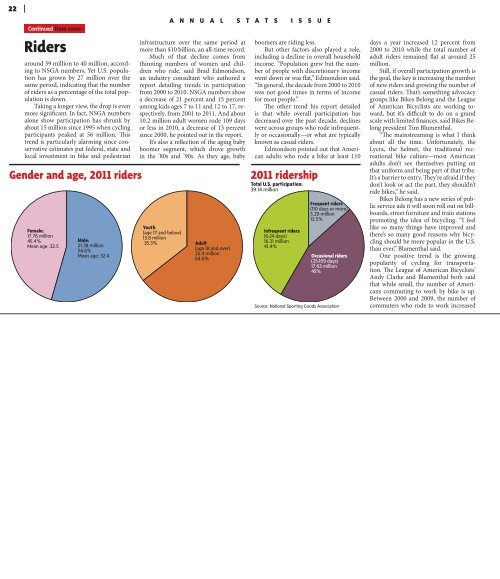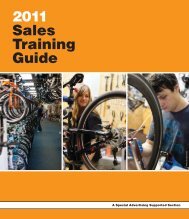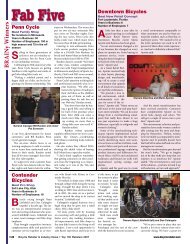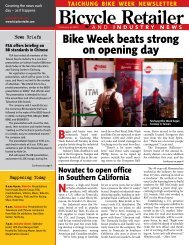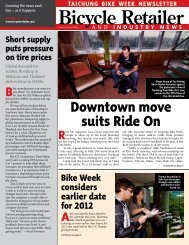Create successful ePaper yourself
Turn your PDF publications into a flip-book with our unique Google optimized e-Paper software.
22<br />
Continued from cover<br />
Riders<br />
around 39 million to 40 million, according<br />
to NSGA numbers. Yet U.S. population<br />
has grown by 27 million over the<br />
same period, indicating that the number<br />
of riders as a percentage of the total population<br />
is down.<br />
Taking a longer view, the drop is even<br />
more significant. In fact, NSGA numbers<br />
alone show participation has shrunk by<br />
about 15 million since 1995 when cycling<br />
participants peaked at 56 million. This<br />
trend is particularly alarming since conservative<br />
estimates put federal, state and<br />
local investment in bike and pedestrian<br />
Gender and age, 2011 riders<br />
Female:<br />
17.76 million<br />
45.4%<br />
Mean age: 32.5<br />
Male:<br />
21.38 million<br />
54.6%<br />
Mean age: 32.4<br />
A N N U A L S T A T S I S S U E<br />
infrastructure over the same period at<br />
more than $10 billion, an all-time record.<br />
Much of that decline comes from<br />
thinning numbers of women and children<br />
who ride, said Brad Edmondson,<br />
an industry consultant who authored a<br />
report detailing trends in participation<br />
from 2000 to 2010. NSGA numbers show<br />
a decrease of 21 percent and 15 percent<br />
among kids ages 7 to 11 and 12 to 17, respectively,<br />
from 2001 to 2011. And about<br />
10.2 million adult women rode 109 days<br />
or less in 2010, a decrease of 13 percent<br />
since 2000, he pointed out in the report.<br />
It’s also a reflection of the aging baby<br />
boomer segment, which drove growth<br />
in the ’80s and ’90s. As they age, baby<br />
Youth<br />
(age 17 and below)<br />
13.8 million<br />
35.3% Adult<br />
(age 18 and over)<br />
25.4 million<br />
64.6%<br />
boomers are riding less.<br />
But other factors also played a role,<br />
including a decline in overall household<br />
income. “Population grew but the number<br />
of people with discretionary income<br />
went down or was flat,” Edmondson said.<br />
“In general, the decade from 2000 to 2010<br />
was not good times in terms of income<br />
for most people.”<br />
The other trend his report detailed<br />
is that while overall participation has<br />
decreased over the past decade, declines<br />
were across groups who rode infrequently<br />
or occasionally—or what are typically<br />
known as casual riders.<br />
Edmondson pointed out that American<br />
adults who rode a bike at least 110<br />
2011 ridership<br />
Total U.S. participation:<br />
39.14 million<br />
Infrequent riders<br />
(6-24 days)<br />
16.21 million<br />
41.4%<br />
Frequent riders<br />
(110 days or more)<br />
5.29 million<br />
13.5%<br />
Occasional riders<br />
(25-109 days)<br />
17.63 million<br />
45%<br />
Source: National Sporting Goods Association<br />
days a year increased 12 percent from<br />
2000 to 2010 while the total number of<br />
adult riders remained flat at around 25<br />
million.<br />
Still, if overall participation growth is<br />
the goal, the key is increasing the number<br />
of new riders and growing the number of<br />
casual riders. That’s something advocacy<br />
groups like Bikes Belong and the League<br />
of American Bicyclists are working toward,<br />
but it’s difficult to do on a grand<br />
scale with limited finances, said Bikes Belong<br />
president Tim Blumenthal.<br />
“The mainstreaming is what I think<br />
about all the time. Unfortunately, the<br />
Lycra, the helmet, the traditional recreational<br />
bike culture—most American<br />
adults don’t see themselves putting on<br />
that uniform and being part of that tribe.<br />
It’s a barrier to entry. They’re afraid if they<br />
don’t look or act the part, they shouldn’t<br />
ride bikes,” he said.<br />
Bikes Belong has a new series of public<br />
service ads it will soon roll out on billboards,<br />
street furniture and train stations<br />
promoting the idea of bicycling. “I feel<br />
like so many things have improved and<br />
there’s so many good reasons why bicycling<br />
should be more popular in the U.S.<br />
than ever,” Blumenthal said.<br />
One positive trend is the growing<br />
popularity of cycling for transportation.<br />
The League of American Bicyclists’<br />
Andy Clarke and Blumenthal both said<br />
that while small, the number of Americans<br />
commuting to work by bike is up.<br />
Between 2000 and 2009, the number of<br />
commuters who rode to work increased


